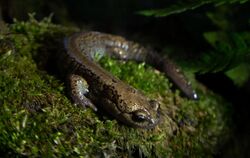Biology:Salamandrella keyserlingii
| Salamandrella keyserlingii | |
|---|---|

| |
| Scientific classification | |
| Domain: | Eukaryota |
| Kingdom: | Animalia |
| Phylum: | Chordata |
| Class: | Amphibia |
| Order: | Urodela |
| Family: | Hynobiidae |
| Genus: | Salamandrella |
| Species: | S. keyserlingii
|
| Binomial name | |
| Salamandrella keyserlingii | |
| Synonyms | |
| |
Salamandrella keyserlingii, the Siberian salamander, is a species of salamander found in Northeast Asia. It lives in wet woods and riparian groves.
Distribution
It is found primarily in Siberia east of the Sosva River and the Urals, in the East Siberian Mountains, including the Verkhoyansk Range, northeast to the Anadyr Highlands, east to the Kamchatka Peninsula and south into Manchuria,[2] with outlying populations also in northern Kazakhstan and Mongolia, northeastern China, and on the Korean Peninsula. It is believed to be extirpated from South Korea. An isolated population exists on Hokkaidō, Japan, in the Kushiro Shitsugen National Park. A breeding ground of Siberian salamanders in Paegam, South Hamgyong, is designated North Korean natural monument #360.[3]
Description
Adults are from 9.0 to 12.5 cm in length. Their bodies are bluish-brown in color, with a purple stripe along the back. Thin, dark brown stripes occur between and around the eyes, and also sometimes on the tail. Four clawless toes are on each foot. The tail is longer than the body. Males are typically smaller than females.[4]
The species is known for surviving deep freezes (as low as −45 °C). In some cases, they have been known to remain frozen in permafrost for years, and upon thawing, walking off.[5] They accomplish this by reducing to a fourth of their body weight through water loss and liver shrinkage, and by increasing the concentration of glycerol in their body.[6]
Discovery
In 1870, Dybowski gave it the name of Salamandrella Keyserlingii. It was renamed in 1910, the 1910 scientific name hardly used. Boulenger gave it the new (but unused) name.
General Behavior
The Siberian salamander is fairly nocturnal, foraging above ground at night and staying under moist logs or woody debris during the day.[7]
Habitat
Within its extensive range, the habitat of the Siberian newt is wet conifer, mixed deciduous forests in the taiga and riparian grooves in the tundra and forest steppe. They can be found near ephemeral or permanent pools, wetlands, sedge meadows, off near oxbow lakes.[8]
Reproduction
Their breeding season occur during May or beginning of June, in pools of water.[9] A single egg sac contains 50-80 eggs on average, with a female typically laying up to 240 eggs in a season. The light-brown eggs hatch three to four weeks after being laid, releasing larval salamanders of 11–12 mm in length.
References
- ↑ Kuzmin, S.; Ishchenko, V.; Matsui, M.; Wenge, Z.; Kaneko, Y. (2008). "Salamandrella keyserlingii". IUCN Red List of Threatened Species 2008: e.T59114A11883606. doi:10.2305/IUCN.UK.2008.RLTS.T59114A11883606.en. https://www.iucnredlist.org/species/59114/11883606. Retrieved 12 November 2021.
- ↑ JSTOR - Emmett Reid Dunn, The Salamanders of the Family Hynobiidae
- ↑ "합수도룡뇽살이터". Encyclopedia of Korean National Culture. http://100.empas.com/dicsearch/pentry.html?s=K&i=280134&v=44. Retrieved 2007-06-11.
- ↑ Hasumi, M., & Borkin, L. J. (2012). Age and body size of Salamandrella keyserlingii (Caudata: Hynobiidae): a difference in altitudes, latitudes, and temperatures. Organisms Diversity & Evolution, 12(2), 167–181. https://doi.org/10.1007/s13127-012-0091-5
- ↑ "How salamanders survive the deep freeze". New Scientist. 11 September 1993. https://www.newscientist.com/article/mg13918902.200-science-how-salamanders-survive-the-deep-freeze-.html.
- ↑ Shekhovtsov, S. V., Bulakhova, N. A., Tsentalovich, Y. P., Zelentsova, E. A., Meshcheryakova, E. N., Poluboyarova, T. V., & Berman, D. I. (2021). Biochemical response to freezing in the siberian salamander salamandrella keyserlingii. Biology (Basel, Switzerland), 10(11), 1172-. https://doi.org/10.3390/biology10111172
- ↑ Hasumi, M., & Borkin, L. J. (2012). Age and body size of Salamandrella keyserlingii (Caudata: Hynobiidae): a difference in altitudes, latitudes, and temperatures. Organisms Diversity & Evolution, 12(2), 167–181. https://doi.org/10.1007/s13127-012-0091-5
- ↑ Hasumi, M., & Borkin, L. J. (2012). Age and body size of Salamandrella keyserlingii (Caudata: Hynobiidae): a difference in altitudes, latitudes, and temperatures. Organisms Diversity & Evolution, 12(2), 167–181. https://doi.org/10.1007/s13127-012-0091-5
- ↑ Hasumi, M., & Borkin, L. J. (2012). Age and body size of Salamandrella keyserlingii (Caudata: Hynobiidae): a difference in altitudes, latitudes, and temperatures. Organisms Diversity & Evolution, 12(2), 167–181. https://doi.org/10.1007/s13127-012-0091-5
Further reading
- "네발가락도롱뇽". Naver Encyclopedia. http://100.naver.com/100.nhn?docid=756322. Retrieved 2007-06-11.
- "AmphipiaWeb". http://amphibiaweb.org/cgi/amphib_query?query_src=aw_lists_genera_&where-genus=Salamandrella&where-species=keyserlingii.
External links
| Wikispecies has information related to Salamandrella keyserlingii |
- Distribution map
- Malyarchuk B., Derenko M. et al. Phylogeography and molecular adaptation of Siberian salamander Salamandrella keyserlingii based on mitochondrial DNA variation, 2010
Wikidata ☰ Q1549384 entry
 |



